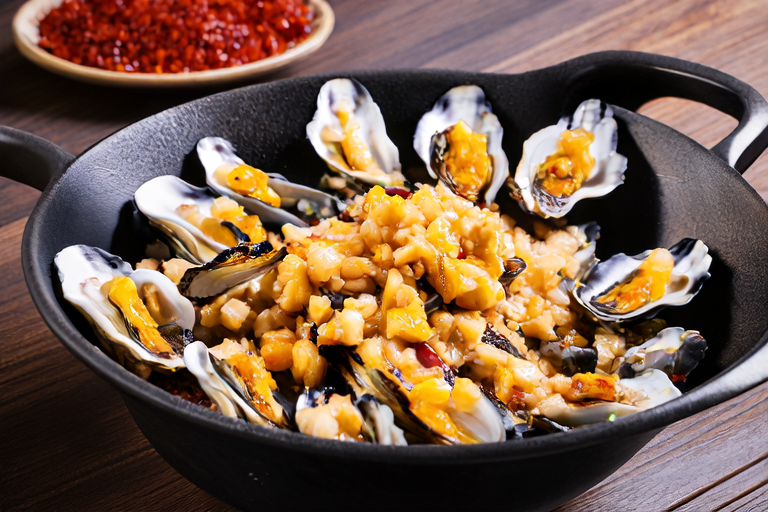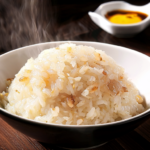Exploring the Flavors of Fujian: A Delightful Seafood Oyster Stir-fry
Fujian cuisine, with its rich history and diverse flavors, is a treasure trove for food enthusiasts. This culinary tradition, deeply rooted in the coastal regions of southeastern China, is renowned for its emphasis on seafood, intricate seasoning, and the use of unique ingredients. Among the myriad of dishes that Fujian cuisine offers, one stands out as a delightful representation of the region’s culinary prowess – the Seafood Oyster Stir-fry. In this article, we will delve into the origins, preparation methods, and nuances of this dish, providing you with a comprehensive guide to recreating this exquisite stir-fry at home.
The Origins and Cultural Significance
Fujian Province, with its extensive coastline and abundant marine resources, has long been a hub for seafood lovers. The Seafood Oyster Stir-fry is not only a testament to the province’s culinary heritage but also a reflection of its cultural values. This dish is often prepared during festive occasions or family gatherings, symbolizing unity and prosperity. The oysters, a staple ingredient in Fujian cuisine, are believed to bring good fortune and are cherished for their delicate flavor and nutritional value.
Ingredients
- Oysters: Fresh oysters are essential for this dish. They should be plump, firm, and free from any unpleasant odors.
- Ginger: A key ingredient in many Chinese dishes, ginger adds a zesty kick and helps to neutralize the slight fishiness of the oysters.
- Soy Sauce: Dark soy sauce is preferred for its richer flavor and deeper color.
- Garlic: Garlic cloves are finely chopped to enhance the aroma and flavor of the dish.
- Spring Onions: Both the green and white parts of spring onions are used for garnishing and adding a fresh crunch.
- Oil: Sesame oil is commonly used in Fujian cuisine for its nutty flavor.
- Scallions: Scallions add an extra layer of flavor and texture to the dish.
- Chili Flakes: For those who enjoy a bit of heat, chili flakes can be added to taste.
- Vegetables: Depending on preference, vegetables such as bell peppers, carrots, or broccoli can be included to enhance the nutritional profile and visual appeal of the dish.
- Seasonings: Salt, sugar, and pepper are used sparingly to balance the flavors.
Preparation Steps
- Prepare the Oysters: Start by rinsing the oysters under cold water to remove any sand or debris. Carefully shuck the oysters, ensuring that the oysters remain intact. Discard any open or damaged oysters.
- Cut the Vegetables: Finely chop the ginger, garlic, and spring onions. Slice the scallions into thin rings.
- Heat the Oil: In a large wok or skillet, heat up some sesame oil over medium-high heat. Once the oil is hot, add the chopped ginger and garlic. Stir-fry until fragrant, being careful not to burn the garlic.
- Add the Oysters: Gently place the oysters into the wok. Let them cook for about 2-3 minutes on each side, until they turn opaque and slightly golden. Avoid overcooking to maintain their tender texture.
- Incorporate the Seasonings: Add a splash of dark soy sauce, a pinch of salt, and a sprinkle of sugar to the wok. Mix well to ensure the oysters are evenly coated with the sauce.
- Stir-fry the Vegetables: If using additional vegetables, add them to the wok now. Stir-fry for another 2-3 minutes until the vegetables are just tender-crisp.
- Finish with Garnishes: Remove the wok from the heat and garnish the dish with the chopped spring onions and scallion rings. Drizzle a little more sesame oil for added flavor and aroma.
Cooking Tips
To achieve the best results when preparing a Seafood Oyster Stir-fry, consider the following tips:
- Choose Fresh Ingredients: The freshness of your ingredients is crucial for the success of this dish. Always opt for fresh, high-quality oysters and vegetables.
- Control the Heat: Cooking over high heat ensures that the oysters retain their natural sweetness and juiciness. However, be cautious not to burn the garlic or overcook the oysters.
- Balancing Flavors: Adjust the amount of soy sauce, salt, and sugar according to your personal taste preferences. It’s important to find the right balance between salty, sweet, and umami flavors.
- Timing is Key: Timing is critical when stir-frying vegetables. Overcooked vegetables can become mushy and lose their vibrant colors, while undercooked vegetables may not have the desired texture.
Serving Suggestions
The Seafood Oyster Stir-fry pairs exceptionally well with steamed rice or noodles. For a complete meal, serve it alongside a simple salad or a side dish of steamed vegetables. The dish’s robust flavors make it versatile enough to complement a variety of accompaniments, making it a perfect centerpiece for any dinner table.
Conclusion
The Seafood Oyster Stir-fry is a true gem of Fujian cuisine, offering a delightful blend of flavors and textures that are sure to please even the most discerning palates. By following the steps outlined in this guide, you can recreate this classic dish at home and experience the rich culinary traditions of Fujian. Whether you’re a seasoned chef or a novice in the kitchen, this recipe promises to be both enjoyable and rewarding. So, gather your ingredients, roll up your sleeves, and embark on a gastronomic journey through the flavors of Fujian.


